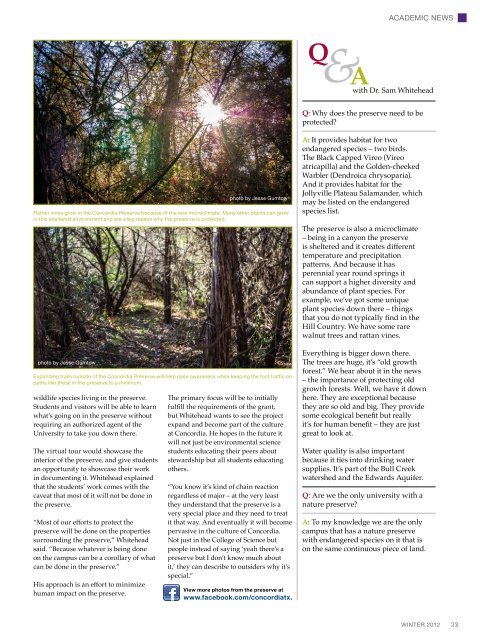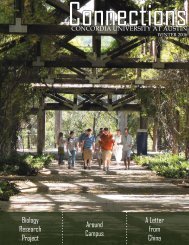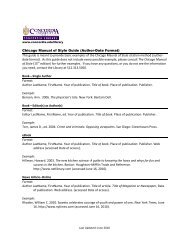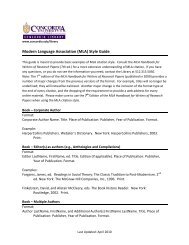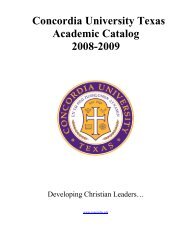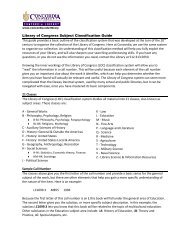WINTER 2012 - Concordia University
WINTER 2012 - Concordia University
WINTER 2012 - Concordia University
Create successful ePaper yourself
Turn your PDF publications into a flip-book with our unique Google optimized e-Paper software.
Q<br />
Academic News<br />
& A<br />
with Dr. Sam Whitehead<br />
Q: Why does the preserve need to be<br />
protected?<br />
Rattan vines grow in the <strong>Concordia</strong> Preserve because of the rare microclimate. Many other plants can grow<br />
in this sheltered environment and are a big reason why the preserve is protected.<br />
photo by Jesse Gumtow<br />
wildlife species living in the preserve.<br />
Students and visitors will be able to learn<br />
what’s going on in the preserve without<br />
requiring an authorized agent of the<br />
<strong>University</strong> to take you down there.<br />
The virtual tour would showcase the<br />
interior of the preserve, and give students<br />
an opportunity to showcase their work<br />
in documenting it. Whitehead explained<br />
that the students’ work comes with the<br />
caveat that most of it will not be done in<br />
the preserve.<br />
“Most of our efforts to protect the<br />
preserve will be done on the properties<br />
surrounding the preserve,” Whitehead<br />
said. “Because whatever is being done<br />
on the campus can be a corollary of what<br />
can be done in the preserve.”<br />
His approach is an effort to minimize<br />
human impact on the preserve.<br />
photo by Jesse Gumtow<br />
Expanding trails outside of the <strong>Concordia</strong> Preserve will help raise awareness while keeping the foot traffic on<br />
paths like these in the preserve to a minimum.<br />
The primary focus will be to initially<br />
fulfill the requirements of the grant,<br />
but Whitehead wants to see the project<br />
expand and become part of the culture<br />
at <strong>Concordia</strong>. He hopes in the future it<br />
will not just be environmental science<br />
students educating their peers about<br />
stewardship but all students educating<br />
others.<br />
“You know it’s kind of chain reaction<br />
regardless of major – at the very least<br />
they understand that the preserve is a<br />
very special place and they need to treat<br />
it that way. And eventually it will become<br />
pervasive in the culture of <strong>Concordia</strong>.<br />
Not just in the College of Science but<br />
people instead of saying ‘yeah there’s a<br />
preserve but I don’t know much about<br />
it,’ they can describe to outsiders why it’s<br />
special.”<br />
View more photos from the preserve at<br />
www.facebook.com/concordiatx.<br />
A: It provides habitat for two<br />
endangered species – two birds.<br />
The Black Capped Vireo (Vireo<br />
atricapilla) and the Golden-cheeked<br />
Warbler (Dendroica chrysoparia).<br />
And it provides habitat for the<br />
Jollyville Plateau Salamander, which<br />
may be listed on the endangered<br />
species list.<br />
The preserve is also a microclimate<br />
– being in a canyon the preserve<br />
is sheltered and it creates different<br />
temperature and precipitation<br />
patterns. And because it has<br />
perennial year round springs it<br />
can support a higher diversity and<br />
abundance of plant species. For<br />
example, we’ve got some unique<br />
plant species down there – things<br />
that you do not typically find in the<br />
Hill Country. We have some rare<br />
walnut trees and rattan vines.<br />
Everything is bigger down there.<br />
The trees are huge, it’s “old growth<br />
forest.” We hear about it in the news<br />
– the importance of protecting old<br />
growth forests. Well, we have it down<br />
here. They are exceptional because<br />
they are so old and big. They provide<br />
some ecological benefit but really<br />
it’s for human benefit – they are just<br />
great to look at.<br />
Water quality is also important<br />
because it ties into drinking water<br />
supplies. It’s part of the Bull Creek<br />
watershed and the Edwards Aquifer.<br />
Q: Are we the only university with a<br />
nature preserve?<br />
A: To my knowledge we are the only<br />
campus that has a nature preserve<br />
with endangered species on it that is<br />
on the same continuous piece of land.<br />
Winter <strong>2012</strong><br />
23


